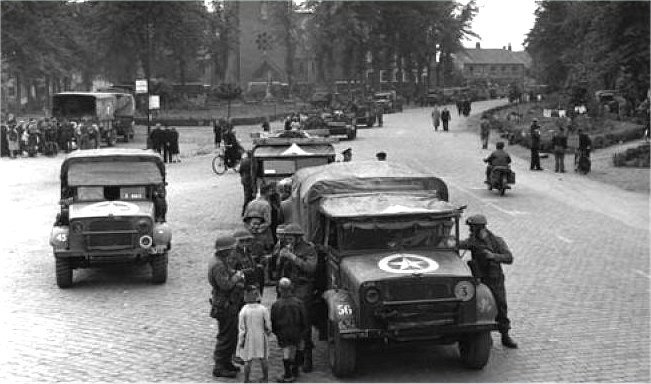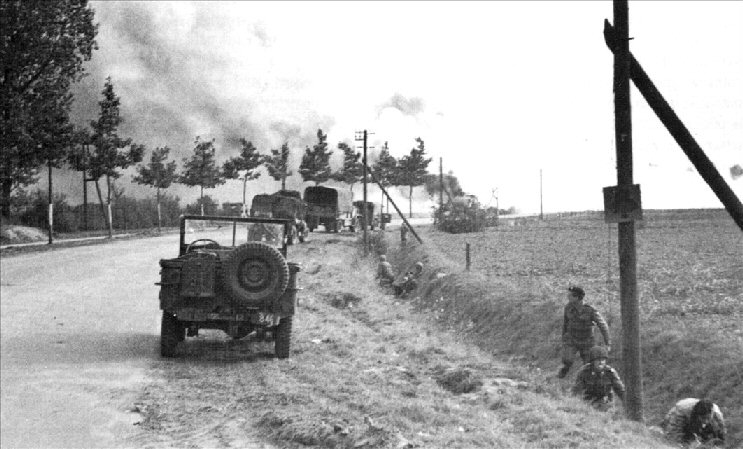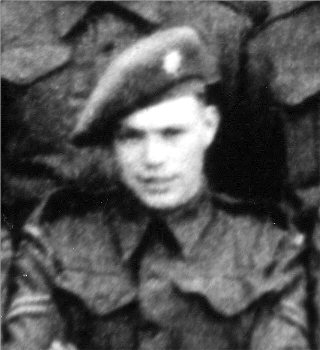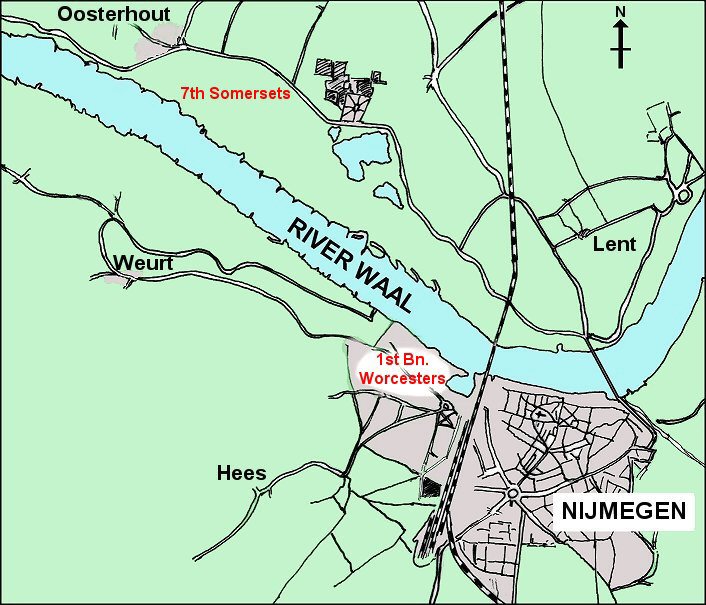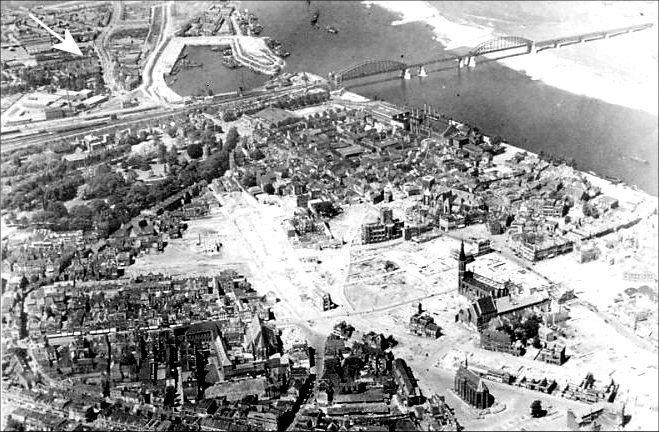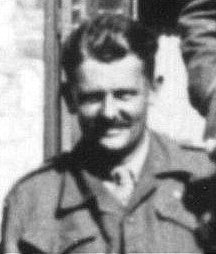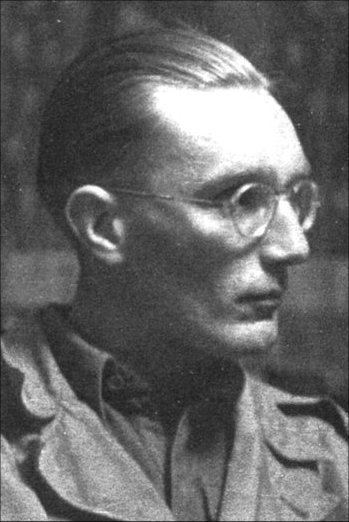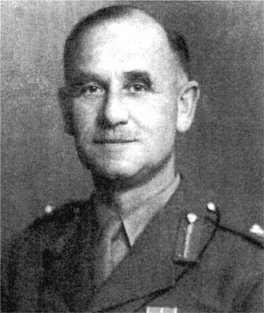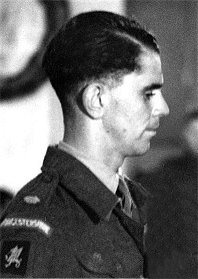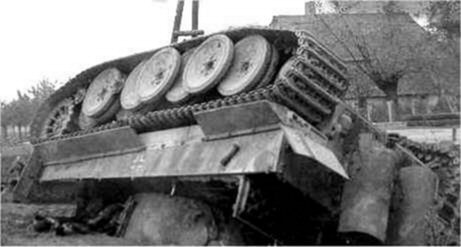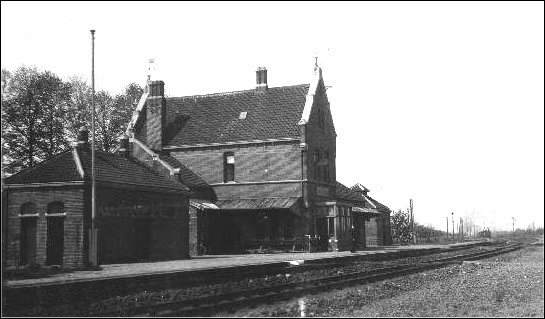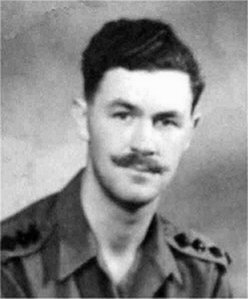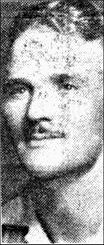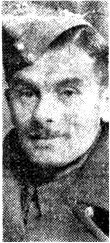Market-Garden (September 1944)
September 1944 would prove to be an eventful month for the 1st Battalion Worcestershire Regiment. Having quickly moved through France and into Belgium they headed towards the Dutch frontier. After a few days rest on the outskirts of Leopoldsburg (Bourg Léopold) they learnt that they would play their part in the now famous operation codenamed “Market-Garden”.
“Market-Garden” was a combined airborne and ground offensive, which involved the airborne division dropping behind German lines. The plan was for them to capture and hold 5 key bridges intact while the ground forces of 30 Corps drove north through Holland on a narrow corridor to hold and consolidate their gain. Thus allowing Allied troops access across the Rhine and into Germany.
It was in these circumstances that the men of the Worcestershire Regiment found themselves battling for control of the small town of Elst just a few miles from Arnhem. Elst was in the centre of low-lying flat boggy polder between the River Waal and the Lower Rhine (Neder Rijn). Although this area came to be referred to by the Allies as the “Island” it is more correctly know as “Betuwe” by the Dutch.
The battle for Elst was to be hard fought with close quarter fighting as the German army occupied virtually every house in the town. To make matters worse allied artillery ammunition was rationed due to the supply line being cut at times by the enemy on the narrow corridor leading up to Nijmegen.
This is the story of the men of the Worcestershire Regiment who after 3 days of close combat fighting liberated the town of Elst. This was achieved with the support of the 7th Somerset Light Infantry and the tanks of the 4/7th Royal Dragoon Guards.
Onward to Belgium
On the 14th September 1944 the 1st Battalion Worcestershire Regiment received orders for a quick move into Belgium, and at 07.00 hours on the following day they left Pressagny L’Orgueilleux where they had been resting after the battle at Vernon and took the road once more.
At about 21.45 hours they arrived at the village of Brain-le-Compte, to the north of Mons, and the next morning continued their journey through Belgium and at 19.45 hours they arrived at the small village of Lummen, near the town of Diest, before moving forward to Leopoldsburg.
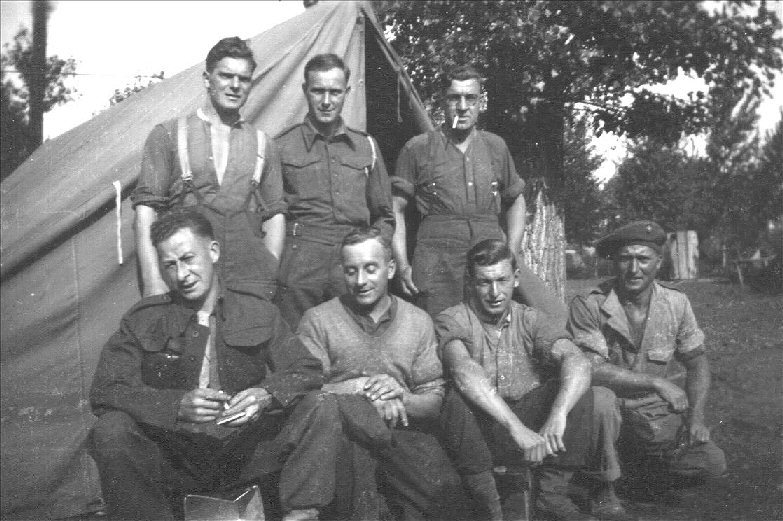
Men of the 1st Worcesters and others at camp Leopoldsburg, Belgium (October 1944)
(Private Thomas Scully back row on the left)
On the 18th September 1944 the battalion received orders to move to a concentration area south-west of Hechtel. Where they once again bivouacked on some sandy-heathered waste ground, which was next to some military barracks at Leopoldburg.
The sandy-heathered waste ground South-west of Hechtel |
It was at Leopoldsburg that the plan for the joint land and air assault on Holland (Market Garden), followed by the proposed right wheel into Germany from the north, was unfolded. 30 Corps, with the Guards Armoured Division leading, were to break out of the bridgehead now established across the Meuse-Escaut Canal and were to head for Eindhoven, Graves, Nijmegen, Arnhem, Appledorn and the sea. They were to be closely followed by the 43rd (Wessex) Division and the 50th Division. The Airborne Army was first to drop at Graves, Nijmegen and Arnhem and to seize the vital bridges across the rivers Maas, Waal and Neder Rijn. |
The Worcestershires’ objective in this operation was to be an area just north of the village of Tenet, roughly a third of the way between Arnhem and Appledorn. A sand-model was built on the heath by the Intelligence Section and around it an “O” Group was held and Company objectives were selected. Orders to be at two hours’ notice to move as from 14.00 hours on the 19th September were received from 214 Brigade H.Q.
The weather was still very warm by day, but the days were rapidly getting shorter and the nights were cold with a heavy wet mist, making early rising a rather miserable business. And so it was at about 16.30 hours on 20th September the 1st Worcesters formed up ready to move out once more to take its place in the seemingly endless column streaming northward towards Eindhoven. The battalion finally left at 18.00 hours on its cold and weary drive north into Holland. After about 30 minutes the Worcesters were crossing Joe’s Bridge (named after Brigadier J. O. E. Vandeleur of the Armoured Guards) across the Meuse-Escaut Canal, west of the village of Neerpelt, and after crossing the Dutch frontier it was now a straight road to Valkenswaard. |
214 Brigade passing through Valkenswaard, 20th September 1944 (IWM_B10148) |
The convoy continued to travel throughout the night at snail’s pace, stopping and starting at very frequent intervals, but although the corridor was at no place more than 800 yards wide, with enemy on either flanks there were no major incidents. This route was later nicknamed “Hell’s Highway”.
Travelling up “Hell’s Highway” |
By first light (21st September) the 1st Worcestershire and the rest of 43rd Division had passed through Eindhoven and at approximately 08.00 hours halted on the road at the village of St. Oedenrode, about eighteen miles south of Graves. After about an hour the column moved on again, heading for the town of Graves. After crossing the River Maas the battalion moved up to the southern outskirts of Nijmegen, where they stopped by the roadside and prepared food. |
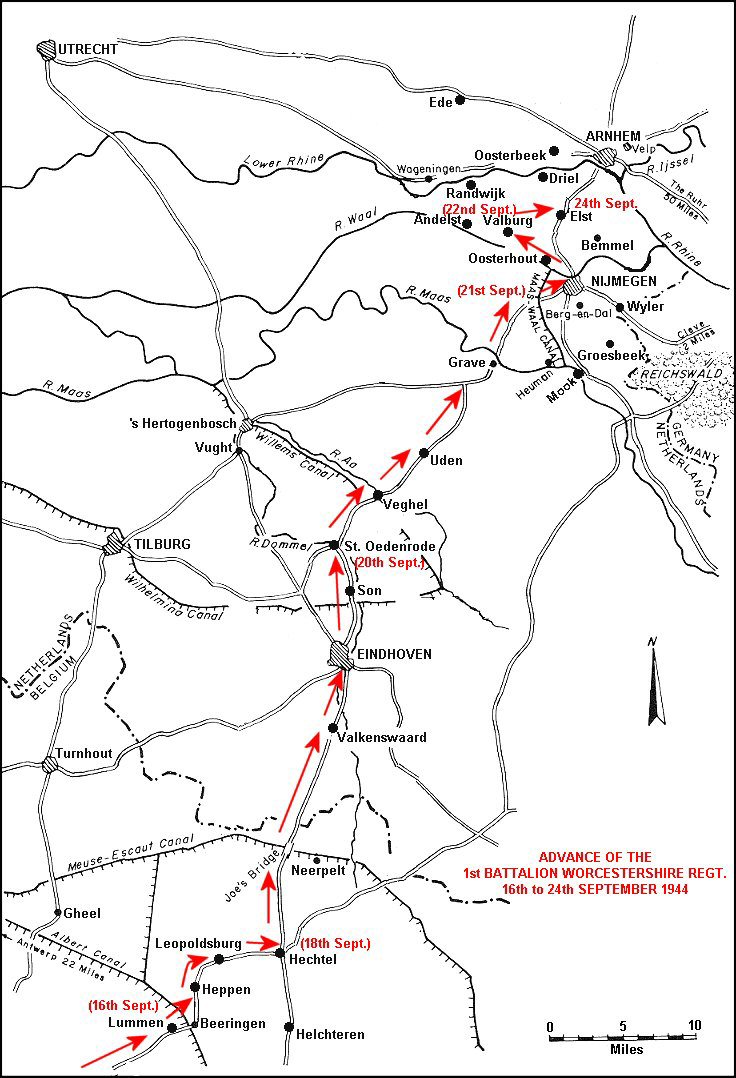
Route taken by the 1st Battalion Worcestershire Regiment and 43rd Division
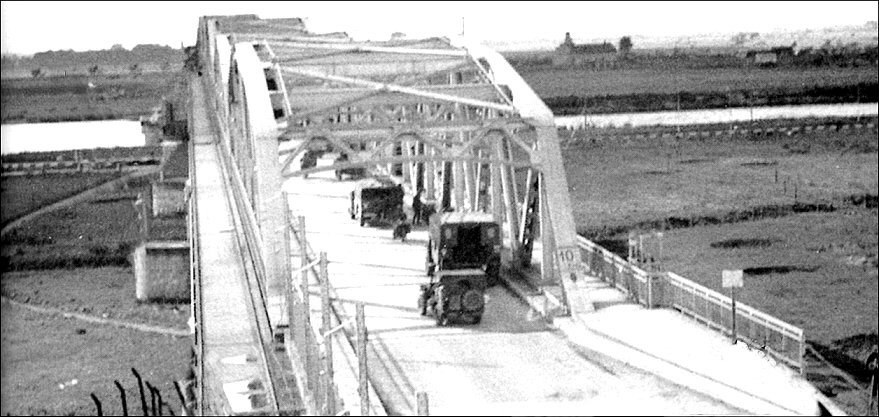
The bridge over the River Maas at Graves
Streets of Nijmegen
Nijmegen at Last
After a short break the 1st Worcesters and the rest of 214 Brigade once again moved forward a short distance to the banks of the River Waal in preparation for their impending advance towards Arnhem. The Battalion now found itself tucked away in the gardens of some houses in the residential district of Nijmegen just west of the railway bridge. It was here that the battalion had its first experience of Dutch hospitality.
The men settled down for the night, which was fairly quiet with only the intermittent sound of the Divisional artillery shelling German positions on the other side of the River Waal. Corporal Bozward (17 platoon, ‘D’ Company), remembers arriving in Nijmegen “We had got somewhere by Nijmegen. It was evening time, just getting dusk, and we were passing by some men of the Guards Armoured Division who were dug in by the roadside. Suddenly the Jerries started to drop a few shells on us and one of the guardsmen said, ‘Don’t get worried, it’s only Jerry sending you a goodnight kiss!’ From somewhere up front a voice quickly replied, ‘It’s you that’s worried mate! If you go any deeper you’ll soon be digging coal!’ There was quite a lot of laughter after that.” Earlier the same day the Guards Armoured Division, who were pushing forward towards Arnhem, on the main Nijmegen – Arnhem highway, were brought to a halt at Elst by tanks and anti-tank guns of the 10th SS Panzer Division. No further advance was made that day. The following morning (22nd September) was dull, cloudy with intermittent rain and mist was hanging over the River Waal. At 07.00 hours the 7th Somerset Light Infantry started its advance over the Nijmegen Railway Bridge and then left following the riverbank towards Oosterhout, at 09.30 their lead company (“D” Company) came under heavy fire south of the village. Their commanding officer Major Sidney Young was mortally wounded and died later the same day. |
Corporal F. H. Bozward |
The Worcestershire Commanding Officer, Lieut.-Col. Osborne-Smith was summoned to attend two “O” Group meetings at Brigade HQ, at 08.00 and 10.00 hours. Brigadier Hubert Essame detailed the plan for 214 Brigade, which involved a left flanking manoeuvre after crossing the Nijmegen Railway Bridge with the 7th Somerset Light Infantry in the lead. The Somersets were to take the village of Oosterhout and once captured the 5th DCLI would pass through and advance quickly with supplies to Driel on the banks of the Neder Rijn and make contact with the Polish gliderbourne brigade. The 1st Battalion Worcestershire Regiment was then to follow and assemble at the village of Valburg in preparation for an attack on Elst the following day.
A tank squadron of the 4/7th Royal Dragoon Guards would support the 3 Battalions of 214 Brigade:
7th Somerset Light Infantry supported by ‘A’ Squadron
5th DCLI supported by ‘B’ Squadron
1st Worcestershire by ‘C’ Squadron
Positions on 22nd September 1944 |
The 1st Worcesters remained in Nijmegen all day awaiting news of the 7th Somersets advance and at 16.00 hours the Battalion C.O. was again called to another ‘O’ Group meeting at Brigade HQ. The 7th Somersets supported by tanks had been held up all day on the outskirts of Oosterhout by a strong contingent of the 64th Panzer Grenadiers. Brigadier Essame now ordered an all out attack supported by a forty-minute fire plan by the Divisional artillery. At 15.20 hours the Somersets attacked again with ‘A’ and ‘B’ companies supported by tanks of ‘A’ squadron of 4/7th Royal Dragoon Guards. This time the attack succeeded and by 16.30 hours the village of Oosterhout was overrun with the Somersets taking 130 German prisoners. The 5th DCLI were now ordered to take advantage of the situation and push forward as quickly as possible to Driel, 10 miles north, on the south bank of the Neder Rijn (Lower Rhine). |
The 5th DCLI organised itself into two columns, one armoured (‘A’ and ‘D’ companies plus tanks of ‘B’ squadron 4/7th Royal Dragoon Guards and a machine gun platoon of the 8th Middlesex), the other soft vehicles (‘B’ and ‘C’ companies). After clearing the western exits of Oosterhout the armoured column of the 5th DCLI moved forward passing through the 7th Somersets and then followed the river bank road passing through the village of Slijk-Ewijk before heading north to Valburg.
Here the local Dutch villagers went wild with joy as the armoured vehicles quickly passed by heading for Driel. At Valburg a despatch rider remained at the crossroads to direct the soft-vehicle column that followed later. As the 5th DCLI armoured column headed for Driel, ‘A’ company who where at the rear suddenly encountered 5 German tanks at de Hoop cross-roads coming from the direction of Elst. The first 3 tanks were quickly destroyed by a combination of PAIT fire and No. 75 mines strung across the road. The 2 remaining tanks toppled over in to the ditches at the road-side as they tried to turn back. The soft-vehicle column of the 5th DCLI were advised of the situation at de Hoop cross-roads and so took a detour and finally joined the armoured column at Driel by 21.00 hours. |
Nijmegen showing Railway Bridge – 1st Worcesters postion marked by arrow |
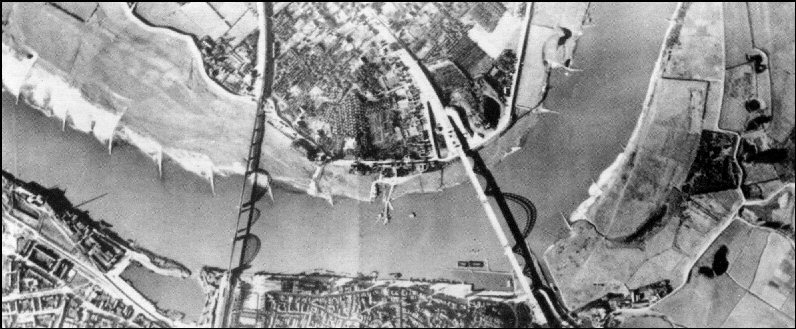
The Railway (left) and Road Bridges over the River Waal at Nijmegen
The 43rd Reconnaissance also moved forward and took up a defensive postion at Slijk-Ewijk.
All Speed to Valburg
Lieut.-Col. Osborne-Smith (Worcestershires C.O.) called together his Company Commanders and explained that the 7th Somersets were to take Oosterhout and the 5th DCLI were to make a dash for the Neder Rijn with supplies as soon as Oosterhout was cleared. The Worcesters were to assist the Somersets where necessary and from now on must be prepared to move at a moment’s notice. The day dragged slowly on when news came in at that the 7th Somersets had been successful and the 5th DCLI had started their dash. The Worcesters were to leave at once and expand the 7th Somersets’ gains. The Commanding Officer then went ahead with his Intelligence Officer (Lieut. Roy Humphreys), as the situation and their role was, to say the least, shrouded with a cloak of vagueness. The Second-in-Command (Major A. A. Grubb) was to guide the Battalion to a previously arranged rendezvous, and so they moved, still in D.U.K.W.S. and with machine guns and tanks of the 4/7th Royal Dragoon Guards in support, and started to crawl through the winding and narrow streets of Nijmegen to the bridges. They crossed over the River Waal by the railway bridge (the Germans had thoughtfully laid planks between the railway lines on one side) and this certainly showed evidence of a grim struggle by the Guards Armoured Division for its possession. |
Lieut.-Col. R. E. Osborne-Smith |
Major A. A. Grubb |
Odd dead Germans lay in grotesque attitudes between the lines; twisted and bent girders gave even greater evidence of the struggle. Once they were across, the bridge was now their lifeline and it was foremost in the news at a later date. It was getting very dark and the pace was punctuated by periods of speed and halts. More halts than speed. Suddenly, through the crackle of interference on the wireless set, was heard the order “All speed for Valburg”. Maps were scanned, anxious looks exchanged. It seemed desperate, one road, nobody on the left or right and miles in front of the nearest troops. No lights were allowed. The road was narrow and bordered on either side by typical Dutch ditches. Not for a long time had it been so dark; a gentle downpour added to the discomfort. Some of the corners were too sharp for the D.U.K.W.S. and they had to manoeuvre backwards and forwards to get round them, tanks skidded into the ditches, and every so often a D.U.K.W. plunged into those cursed dykes, drenching all those on board but causing no injuries. Dutch people peered anxiously from behind their darkened windows and watched as the Worcesters went by. Finally at 22.00 hours the 1st Worcesters reached Valburg crossroads, as it was late there was no time for recces, no information. The commanding officer deployed ‘C’ Company right, ‘B’ Com¬pany forward, ‘A’ Company left near Valburg railway station, ‘D’ Company and Supporting Arms to the rear, Battalion Headquarters was set up in a public house at the main cross-roads in the village. All was quiet but this was not to last! The signallers quickly laid communication lines out to the Companies. Unfortunately Brigade H.Q. was too far away, and therefore out of touch by wireless. Rumours started to pour in of tanks being heard and the sounds of men forming up, but no attack materialized. The Commanding Officer (Lieut.-Col. Osborne-Smith) called an ‘O’ Group in his headquarters and by candlelight over a glass of Dutch beer the chaos was sorted into a clear picture. |
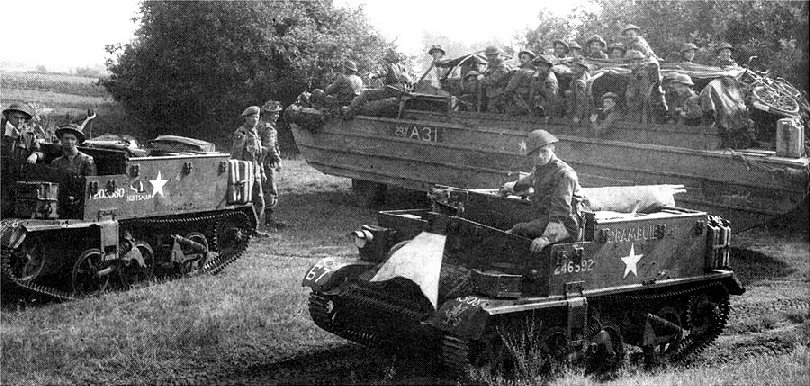
Battalion transported in D.U.K.W.’s
However, until 130 Brigade, who had priority on the road, had cleared Valburg cross-roads, it was impossible for 214 Brigade to start their day's task—the capture of Elst. The only road available for their mortars, carriers and anti-tank guns ran through Valburg. Movement by any type of vehicle across the soggy fields was quite out of the question. Some difficulty was experienced in explaining this embarrassing fact to Major-General Thomas on the wireless. He accordingly arrived at Valburg cross-roads to verify the situation in person. Here he found Brigadier H. Essame, the Commander of 214 Brigade, and his commanding officers seated round the bright green billiard table of the local public house engaged in settling the final details for the advance on Elst, now at last feasible. A more than usually vicious concentration of German 88mm shells, which smashed all the windows and killed several men outside, greeted his arrival. In the circumstances his opinion, expressed with his normal brevity and force, that the rendezvous was ill chosen, must be regarded as fair comment. A second salvo, equally well directed, brought the conference to an even speedier conclusion than the normal in this brigade. Whilst the Worcesters were in Valburg they came in contact with the Dutch “Orange” underground move¬ment, who provided valuable information on the German positions in the area. Today the location of the public house which was at the Valburg crossroads, used in September 1944 as 1st Battalion Worcestershires and 214 Brigade HQ’s, no longer exists having been replaced by a supermarket store. |
Brigadier H. Essame |
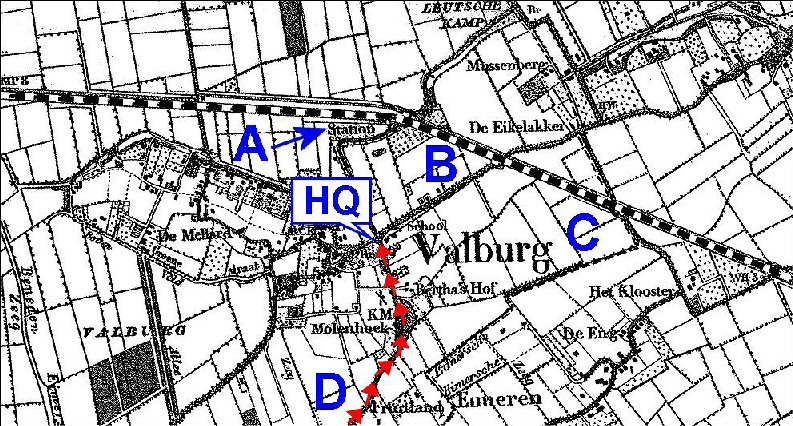
Positions of the 1st Battalion Worcestershire Regiment companies at Valburg (22nd/23rd September 1944)
During the night ‘C’ Company kept reporting a tank by their positions, describing a roaring engine and sounds of tracks but of no firing. Just by their position was a level-crossing, and here, evidence of the 5th DCLIs’ dash was depicted in the shape of two brewed-up carriers and two lives sacrificed.
Captain Peter Hall |
Captain Peter Hall, recalls; “’C’ Company was ordered as night fell, to patrol forward. This we did in an area West of Elst. A rather beautiful Dutch farm with outbuildings was our forward headquarters. I was ordered to reconnoitre, at night, a pine woods area about half a mile to the East of ‘C’ Companies established firm base. At about 23.00 hours, my patrol partner and I passed through our forward Company positions - and into the unknown! Without incident we got to the wood. I ordered my partner to stay just within its edge and listen out while I went into the wood to try to determine the situation. It was an eerie experience. As I crept forward into the wood, I could hear muffled cries. I could not identify the language or the sound of the tracked vehicles. At that time the situation was very fluid. I did not know whether these units were elements of the Guards Armoured Division or 21 Panzer Grenadiers. I was disinclined to march forward and say, “Hi, fellows!” in case I got it wrong. I crouched in the undergrowth for an eternity (actually only about 15 minutes) and found myself only about 30 yards from all of this activity. Suddenly, there was a loud, metallic crash! Two vehicles had collided in the dark. There was an explosive shout of ‘Dumkopf!’ At last I had my answer. I rejoined my partner and, without further incident, we got back to Company lines I reported to my company commander Major Jerry Clover. He organised an Artillery ‘stonk’ in the wood - the result of which I never knew because.... I was allocated a sleeping place in the farmhouse. I grabbed a bale of hay on which I intended to sleep. I walked through an unseen open trap door and fell 15 feet onto hard concrete! This did not make me very mobile the next day and I was evacuated to ‘A’ Echelon for 24 hours rest.” |
The night gradually gave way to dawn (23rd September) and ‘C’ Company solved their tank problem, for just in front of their position was a ditched Panther—the crew gave themselves up, four young Hitler Youths. As the day progressed, interested Dutchmen came out of their houses to see this sudden change in their village life. Strange figures came into Battalion H.Q. dressed in half Dutch and half Air Force clothing. They were crews from crashed aircraft who hidden by the Dutch and hearing of our arrival, came out so that we might send them back to the nearest airfield. They gave us valuable information as to where equipment dropped from aircraft and destined for the Airborne Forces had been hidden by them to prevent it from falling into enemy hands. A great amount had been dropped but sadly on the wrong side of the river. |
|
The crossroads were now securely in our hands. 130 Brigade had passed straight through Valburg and a long column started to materialize, moving northwards. The noise of the column must have aroused the Germans for they thereupon started to shell the crossroads and, very soon, on the once unmarred village the hand of war descended. Roofs crashed down, houses were blasted, D.U.K.W.S. received direct hits and the once interested sightseers scurried to the comparative safety of their cellars. Casualties started to arrive at the R.A.P. and it was here that the Provost Sergeant (Sergt. George Ridler) was killed in company with four or five other ranks. To the reader a crossroads may sound a very foolish position to site Battalion Headquarters but, during the chaos of the previous evening, this appeared to be the only available place.
Mortar Platoon commanded by Captain Jock Bannister now prepared to give the forward companies supporting fire for the following days advance on Elst. However, 3-inch mortar shells were in short supply due to the supply line being cut by the Germans between Veghel and Uden. By midnight on the 23rd September 30 Corps had control once again of the main highway north to Nijmegen and after tanks and bulldozers nudged damaged vehicles aside the main supply corridor was open once more.
Valburg Railway Station |
Captain Jock Bannister |
The Battalion, being self-supporting as it was not expected that any maintenance would get through, brought out the ever-saving compo and proceeded to have breakfast. Just as they had finished, who should drive up but the maintenance column from ‘A’ Echelon carrying a cooked breakfast! After their efforts in getting it up to them the men felt that the least they could do was to show their appreciation, so they set to and ate a second breakfast.
CQMS Sanders |
This is perhaps a suitable moment to pay some tribute to the work of ‘A’ Echelon, which was never better than in this sector. When the Battalion first crossed the Nijmegen railway bridge, ‘A’ Echelon, where all the meals are cooked, was left behind on the south side of the river on the western outskirts of the town. The bridge became the target of everything the Germans could hurl at it; their efforts to destroy it became frantic. Fighter-bombers came over in waves; shells crashed down on it. It was over this bridge, twice a night, that the Company Quarter-Master Serjeant Sanders, the cooks and the drivers (L/Cpl. Beech) had to run this gauntlet of fire. The first night was the worst. But the hot meal he was carrying was safely delivered to the hungry men. On the return journey, shells were still falling around the bridge, but no one was hurt. A few hours later, the ordeal had again to be faced, this time with the breakfast meal. Much of the food which the Battalion was eating at this time was German. An enormous enemy food dump had been captured near Nijmegen; it was said to be so large that the Germans were drawing supplies from one end at the same time as the British from the other! This was a godsend, for the narrow lines of communication stretching back into Belgium had been severed by the enemy, and for most of the first week of the operation the whole of 30 Corps was cut off from its supplies. |
L/Cpl. Beech |


